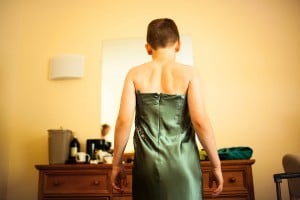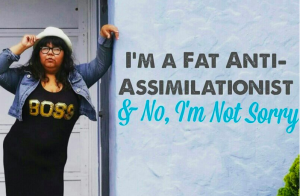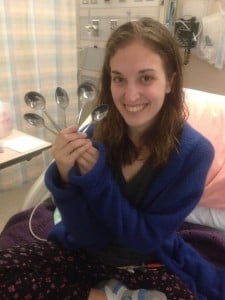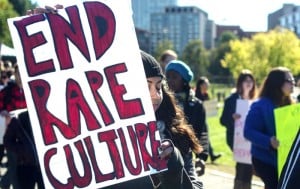Originally published on Role/Reboot. Reposted here with permission.
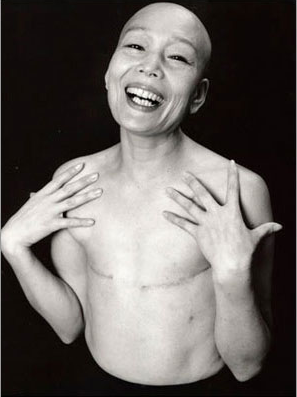
Credit: Trix Rosen. Please note that this is not the author.
Melanie Testa decided not to have reconstructive surgery after cancer, and is still figuring out how to navigate the world as a flat chested woman.
Being diagnosed with breast cancer is like a smack upside the head. It is numbing, frightening, and blinding all at once. The health professionals allow no time for thinking—the doctors and nurses bombard the patient with care and huge amounts of information, deciding on the best personal treatment protocol or staging, as the lingo for it goes. So the plan for me was chemo, followed by surgery, followed by radiation.
Luckily for me, I was advised to have neoadjuvant chemotherapy. This treatment approach, which is designed to shrink the cancer as much as possible prior to surgery, allows the female patient time to evaluate her situation and make empowered, conscientious decisions that are right for her, since chemotherapy treatments are given over a several month period of time.
I say lucky for me because the other decision I would be forced to make is whether or not to reconstruct my breasts. So, the neoadjuvant chemotherapy allowed me the time to examine my options, talk with plastic surgeons and my breast surgeon, as well as get online to see what decisions others had made and why they had made them.
My husband and I went to the plastic surgeon appointment with open minds. If I were to decide on reconstruction, I would need a total of four surgeries to complete the process—the mastectomy, which is when the expanders are placed, the exchange (where the expanders would be replaced with implants), nipple reconstruction, and outpatient tattooing of the nipples. It was advised that the silicone in the implants be “exchanged” every seven years.
Wow, that was a lot to take in. When the doctor ducked out to get an advertisement for silicone implants, I looked at my husband and said “I don’t want any of this.”
Ironically, no one actually suggested that I just go “flat.”
We returned home a mess: What was there to do? So I went online and within 10 minutes found some gorgeous photographs of a young mother, topless and flat, throwing rocks and having a fine time playing with her kids on the beach. Her body was beautifully healed—she’d had a bilateral mastectomy with no reconstruction. Her body type was similar to mine—I could imagine looking just as beautifully inspiring as she did. I called my husband to the computer and asked if he was comfortable with the simplicity of not reconstructing my body, using the same approach as the lovely young mother had. He agreed without hesitation.
Which brings me to the real story: I am now a flat chested woman. A flat chested woman living in a society where women’s bodies sell everything—whether it’s cars, alcohol, shampoo, whatever—on television, in magazines, or online. And most of those ads feature big breasts and low cut tops.
As a result, the socially accepted version of a woman in our society is that of a thin woman with big breasts and long legs.
Now that my body image is changed (a change I am still getting used to), I get some very curious looks while out and about in my daily life. Recently something I knew was bound to happen actually did happen: A man walked past me, looked twice, and yelled “you look like a man!” I was affected. And not because of the comment. But because this man was verbally lashing out. His idea of gender was disturbed. Would verbal abuse turn into physical abuse? I immediately began to question myself: Should my style of dress be more feminine to make up for being flat chested? Do I care enough? I decided that I don’t care enough. But in the face of bad behavior like this, I can see why many women wear breast forms and try to pass for having a socially acceptable body.
Surprisingly, up to 45% of women in this country get reconstructive breast surgery after facing breast cancer. So where are the other 55%? I don’t recall ever seeing a completely flat chested woman (or, for that matter, a one-breasted woman) in my entire life. If one in eight women (12%) in the United States will be diagnosed with breast cancer in their lifetime, where is the breast-less clan of women?
Even today, when the United States is at its most egalitarian, women still do much of the care giving in our society. Does the desire to either reconstruct or use prosthetics for breasts stem from our need to continue to be the caregiver to those around us by presenting a picture of normalcy? Is it to cover up the fact that breast cancer is still an insidious disease that carries a stigma? Plus, if we reconstruct or use artificial breast forms, how do we find one another? Can’t going flat be offered as an option to the breast cancer patient, just as reconstruction is offered? Can’t going flat be sexy, strong, and beautiful?
I think there are several reasons I don’t see more flat women. Gender perception or being received and understood as female is at the top of the list. From the standpoint of a woman who has chosen not to reconstruct her body, I can say that people really do want to classify and sort you into a specific gender.
Finding appropriate clothing isn’t easy. The majority of women’s clothing has bust darts and shaping that hangs poorly on a body without breasts. One would think that with so many women facing breast cancer and living with the results of their decisions, someone would have a line of clothing specifically intended for women who are half flat or flat. Plus, many women who have gone through treatment and gotten reconstruction have two differently sized breasts. And—whether a woman has a single breast, differently sized breasts, or none at all—we want to look pretty, sexy, desirable, and just plain visible. But in our own way, not the way portrayed by the media.
So, if you are half flat or flat, please put away your breast forms once in a while, show the beautiful new you off and help to raise true awareness of breast cancer by embracing that strong and vibrant body of yours. Contact your favorite clothing manufacturer and tell them what you would like to see in a line of clothing directed at our demographic. And to the silly, misinformed, misguided people who find comfort in categorizing your gender presentation? Remember that you have been through much worse and are stronger for it. Gender assumptions have no place in this discussion.
Melanie Testa is an artist and author, living in Brooklyn, New York.
Search our 3000+ articles!
Read our articles about:
Our online racial justice training
Used by hundreds of universities, non-profits, and businesses.
Click to learn more
Most Read Articles
- « Previous
- 1
- …
- 30
- 31
- 32









